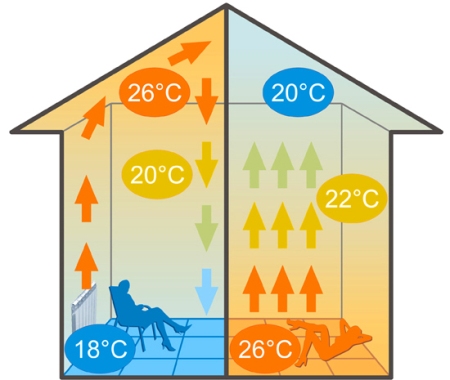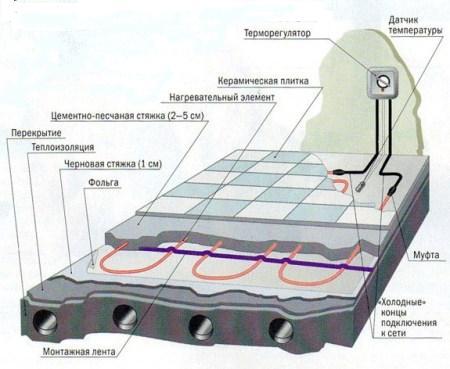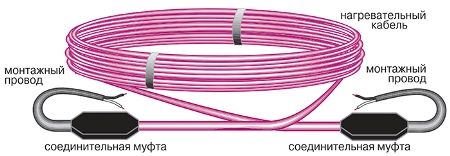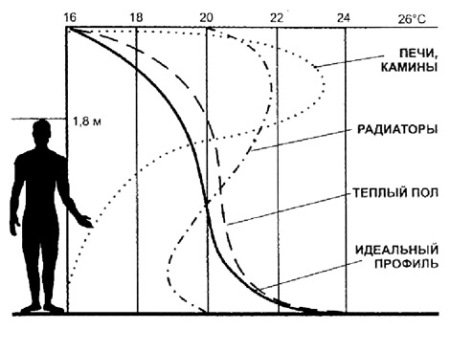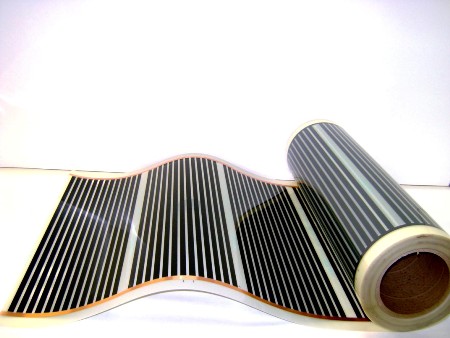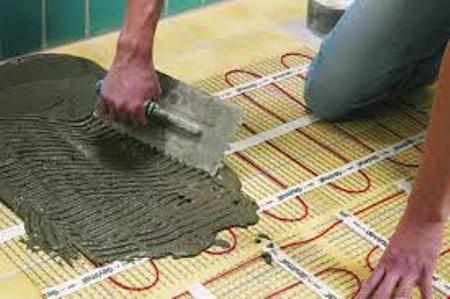If we talk about a cozy house, we should first of all mention heat - it warms not only the body, but also the soul of the owners of the house. Therefore, the issue of heating the room is always considered with particular severity. Today, people tend to make housing more ergonomic, equipped in accordance with modern high technology, the issue of saving money also leaves homeowners indifferent. Therefore, in addition to the traditionally used heating systems for private houses or centralized heating, which is most often installed in urban apartments, alternative types, in particular, warm floors, are becoming increasingly popular.
Content
- 1 What are the warm floors, their features
- 2 Warm floor electric in the house - advantages and main principles of arrangement
- 3 Electric floor heating - which is better
- 4 Advantages of warm electric floors
- 5 Electric floor heating, which is better - infrared or cable
- 6 Warm electric floors - how to choose the best option for your home
What are the warm floors, their features
Warm electrical floor has long lost the status of "pleasant luxury": simple to operate, requiring minimum maintenance costs, it has become an indispensable and important functional part of the heat supply system at home.
It should be noted that warm floors do not belong to modern inventions - they were used very successfully by rich inhabitants of Ancient Rome to heat their baths. Air was used as the coolant, which passed through special canals, arranged in the underground. To heat the air, furnaces were built.
Since the I c. BC and to the present day in Korea, the ondol is very successfully used - a kind of heating system, consisting in the arrangement of warm cavities in the floor. And if for the European countries, warm floors have only recently been a wonder, but today in the Scandinavian countries they heat about half of all apartments.
An attractive moment in using a warm floor is the ability to provide a sufficiently high level of comfort in the room. The temperature at different distances from the floor is from +24 C to +16 C, which is the most optimal option for the human body, the feet are warm, at the head level, the temperature is only 16, this regime favors the maintenance of excellent performance and activity.
The difference in the temperature of the surface of the warm floor and air in the room is of the order of a couple of degrees, whereas when heating with water radiators the difference in the temperatures of the surfaces of the radiator and air in the room is about 50 degrees.
Warm floors, depending on the design, can be water or electric, while electrical, because of their ease of installation and convenience, are equipped more often.
Warm floor electric in the house - advantages and main principles of arrangement
The warm electric floor is heated from a special electric cable laid under it, the characteristics of the floor itself and the duration of its operation depend on the quality of the cable. Cable heating occurs when the voltage is applied to 220 V, because of the high resistance of the material from which the cable is made, it heats up. This leads to the heating of the entire concrete layer of the structure, usually it is from 3 to 8 cm.
Use of warm electric floors can be used as the main and additional source of heating:
- in the first case it will be necessary to install more powerful heating elements, about 150-180 W per square meter,
- in the second - there will be enough elements with a capacity of 110-120 W per sq.m.
How to install the heating cable can be viewed on the video:
Electric floor heating - which is better
To choose the most suitable type of warm electric underfloor heating, you should familiarize yourself with the advantages and disadvantages of each of its three types.
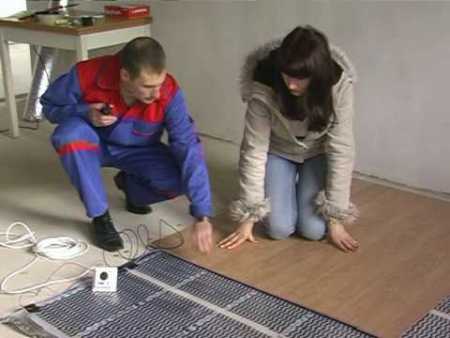
Infrared, or film. Installation of such a floor will take several hours, the installation will allow heating a country house or some part of it, with no special financial costs required, the work will be done quickly, and the room volume will not decrease.
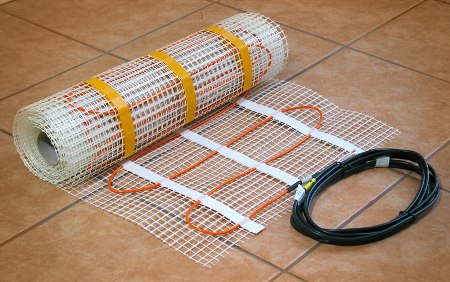
The warm floor electric under a laminate or a parquet board will allow to receive qualitative heating of one room or the whole cottage.
After watching the video, you can see the technology of laying the film floor
Heating mats. The horsepower is quite low, about 10 W / m, their installation can be done in a layer of glue, which will be laid tiles. The mats are a mesh with a reinforced cable, during installation the mats are spread over the floor. If the need arises, the grid can be cut, but the integrity of the cable can not be violated at the same time. Use such a heating system can be after the glue has dried, i.e. a couple of days after stacking. From the advantages of this option, it should be noted that the cable is shallow - when turned on, the warm floor warms up very quickly.
Heating cables. Their laying is carried out at a considerable depth in the thickness of the cement-sand screed (about 3-5 cm), the reason for this is a rather high power, about 10-25 W / m. It's quite difficult to lay this kind of electric floor with your own hands, of course, if there is no appropriate preparation. The heating system of this type can be switched on after the solution has dried completely, i.e. 28 days after the installation works.
Advantages of warm electric floors
Let us once again recall the main advantages that homeowners receive when installing a warm electric floor:
- the opportunity to get maximum comfort with minimal expenditure of funds,
- provide a uniform and soft supply of heat energy throughout the area,
- avoid the drop in the indicator of humidity in the room, the ability to maintain conditions that are optimal for people's lives and activities,
- the ability to preserve the cubature of the room, get rid of the radiators and pipes on the walls and in the niches under the windows,
- to exclude the possibility of negative influence of the kind of heating devices on interior design.
Electric floor heating, which is better - infrared or cable
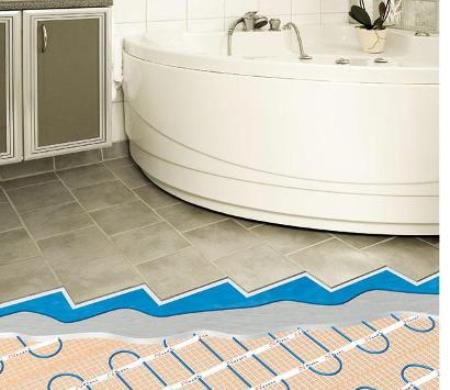
Previously, the trading network offered only two types of warm electric floors, which practically did not differ in principle: the choice between heating cables and mats was carried out depending on the features of the heated room and the willingness to spend a certain amount on laying the floor.
The appearance of infrared film heaters has caused heated discussions between manufacturers. Manufacturers of infra-red heating systems unanimously assert their significant advantages. The main of which is the beneficial effect of infrared radiation on the human body. Official medicine does not disprove this claim, moreover, infrared radiation is very successfully used in the treatment of some serious diseases.
The whole problem of using infrared film heaters lies in the fact that traditionally used flooring materials, such as laminate, tile, linoleum, are practically impervious to infrared rays. Those. to ensure that infrared radiation will pass through the floor covering and have a beneficial effect on health is almost impossible, statements about the medical properties of floors with infrared heating - nothing more than a marketing move.
Among the advantages of infra-red heating systems, we can note a fairly economical expenditure of electricity, its consumption is reduced by about 20%.
The reasons for this phenomenon are quite understandable:
- absence of heat losses,
- laying without screed.
If we consider the issue from the point of view of safety and practicality, then it turns out that:
- the warm infra-red floors themselves practically do not have a protective layer, which prevents the possibility of mechanical damage,
- a person, moving on the floor, is more exposed to the risk of electric shock.
Of course, you can resort to installing films that are powered by 12 V, but this option involves the inclusion in the system is a very unreliable element - the power supply.
Warm electric floors - how to choose the best option for your home
If we consider other facts that implementers of infrared films put forward as their merits, then we should remember the possibility of replacing parts of the film in the event of damage. Simplicity of repair provides a parallel connection of heating elements. Nevertheless, it can be argued that it is the junction points that are the weakest and most unreliable place of heating systems of this type. In contrast to this fact, it can be seen that the heating cable is an integral element, the system in which it is used has only one unreliable point - the clutch, but its location is indicated in the passport, in case of breakage it is also easy to replace.
Analyzing the foregoing, we can conclude that the use of infrared films will be the best option for floor heating in the event that serious repair work is not planned. After all, for laying the films it will only be necessary to lift the existing coating and lay the film under it.
It is recommended to install an infrared floor if, for some reason, it is impossible to make a cement-sand screed, in particular, if there is no possibility to raise the floor level.
Specialists recommend laying a heating cable for heating floors in bathrooms, children's rooms, on loggias and balconies. Cable heating systems have better waterproofing, i.e. guarantee greater protection from electric shock. In addition, it is easier to lay ceramic or tile tiles on a cement screed.
According to experts, the option of using infrared heating systems will find the widest possible distribution in the near future, provided that its creators will eliminate the minor flaws inherent in such systems. But to date, most consumers still prefer installing heating cables.




